Icosioctagon
| Regular icosioctagon | |
|---|---|
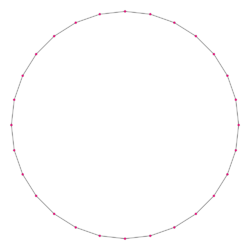 A regular icosioctagon | |
| Type | Regular polygon |
| Edges and vertices | 28 |
| Schläfli symbol | {28}, t{14} |
| Coxeter diagram | |
| Symmetry group | Dihedral (D28), order 2×28 |
| Internal angle (degrees) | ≈167.143° |
| Dual polygon | Self |
| Properties | Convex, cyclic, equilateral, isogonal, isotoxal |
In geometry, an icosioctagon (or icosikaioctagon) or 28-gon is a twenty eight sided polygon. The sum of any icosioctagon's interior angles is 4680 degrees.
Regular icosioctagon
The regular icosioctagon is represented by Schläfli symbol {28} and can also be constructed as a truncated tetradecagon, t{14}, or a twice-truncated heptagon, tt{7}.
The area of a regular icosioctagon(28 sided polygon) is: (with t = edge length)
- [math]\displaystyle{ A = 7t^2 \cot \frac{\pi}{28}. }[/math]
Construction
As 28 = 22 × 7, the icosioctagon is not constructible with a compass and straightedge, since 7 is not a Fermat prime. However, it can be constructed with an angle trisector, because 7 is a Pierpont prime.
Symmetry
The regular icosioctagon has Dih28 symmetry, order 56. There are 5 subgroup dihedral symmetries: (Dih14, Dih7), and (Dih4, Dih2, and Dih1), and 6 cyclic group symmetries: (Z28, Z14, Z7), and (Z4, Z2, Z1).
These 10 symmetries can be seen in 16 distinct symmetries on the icosioctagon, a larger number because the lines of reflections can either pass through vertices or edges. John Conway labels these by a letter and group order.[1] The full symmetry of the regular form is r56 and no symmetry is labeled a1. The dihedral symmetries are divided depending on whether they pass through vertices (d for diagonal) or edges (p for perpendiculars), and i when reflection lines path through both edges and vertices. Cyclic symmetries in the middle column are labeled as g for their central gyration orders.
Each subgroup symmetry allows one or more degrees of freedom for irregular forms. Only the g28 subgroup has no degrees of freedom but can seen as directed edges.
The highest symmetry irregular icosioctagons are d28, an isogonal icosioctagon constructed by ten mirrors which can alternate long and short edges, and p28, an isotoxal icosioctagon, constructed with equal edge lengths, but vertices alternating two different internal angles. These two forms are duals of each other and have half the symmetry order of the regular icosioctagon.
Dissection
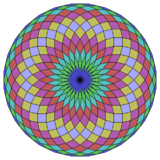 regular |
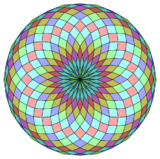 Isotoxal |
Coxeter states that every zonogon (a 2m-gon whose opposite sides are parallel and of equal length) can be dissected into m(m − 1)/2 parallelograms. In particular this is true for regular polygons with evenly many sides, in which case the parallelograms are all rhombi. For the regular icosioctagon, m = 14, and it can be divided into 91: 7 squares and 6 sets of 14 rhombs. This decomposition is based on a Petrie polygon projection of a 14-cube.[2]
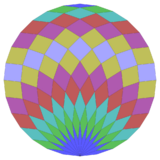
|
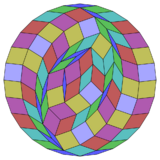
|
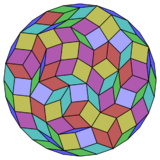
|
Related polygons
An icosioctagram is a 28-sided star polygon. There are 5 regular forms given by Schläfli symbols: {28/3}, {28/5}, {28/9}, {28/11} and {28/13}.
 {28/3} |
 {28/5} |
 {28/9} |
 {28/11} |
 {28/13} |
There are also isogonal icosioctagrams constructed as deeper truncations of the regular tetradecagon {14} and tetradecagrams {28/3}, {28/5}, {28/9}, and {28/11}.[3]
| Isogonal truncations of regular tetradecagon and tetradecagrams | |||||||||||
|---|---|---|---|---|---|---|---|---|---|---|---|
| Quasiregular | Isogonal | Quasiregular | |||||||||
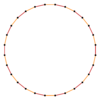 t{14} = {28} |

|
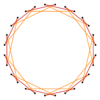
|
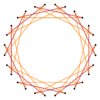
|
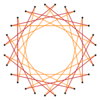
|

|

|
 t{14/13}={28/13} | ||||
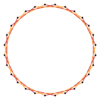 t{14/3} = {28/3} |
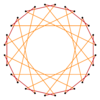
|
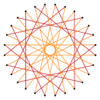
|
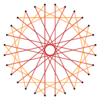
|
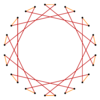
|
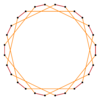
|
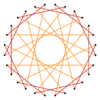
|
 t{14/11}={28/11} | ||||
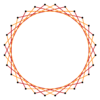 t{14/5} = {28/5} |

|
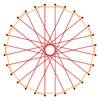
|
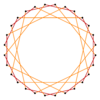
|
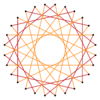
|
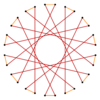
|

|
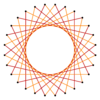 t{14/9}={28/9} | ||||
References
- ↑ John H. Conway, Heidi Burgiel, Chaim Goodman-Strauss, (2008) The Symmetries of Things, ISBN:978-1-56881-220-5 (Chapter 20, Generalized Schaefli symbols, Types of symmetry of a polygon pp. 275-278)
- ↑ Coxeter, Mathematical recreations and Essays, Thirteenth edition, p. 141
- ↑ The Lighter Side of Mathematics: Proceedings of the Eugène Strens Memorial Conference on Recreational Mathematics and its History, (1994), Metamorphoses of polygons, Branko Grünbaum

